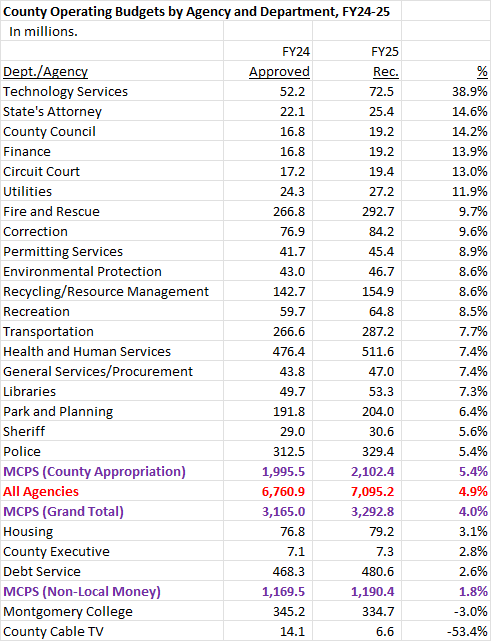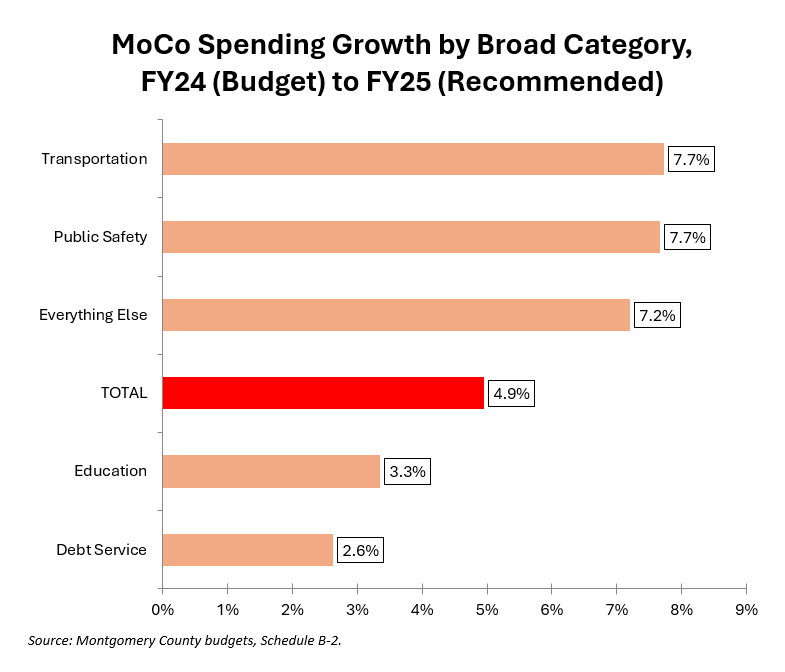By Adam Pagnucco.
County Executive Marc Elrich released his recommended FY25 operating budget on March 14. That same day, I published my first impressions of his budget, which were:
- No property tax increase.
- MCPS is getting a $128 million increase, which is most of what it wants. Predictably, the school board president began discussing the possibility of “reductions,” but that’s not accurate – MCPS is getting a budget increase.
- Relative to the population, there will now be 10.49 county government FTEs per 1,000 residents, the highest level in at least 25 years.
- The budget contains generous union contracts with most employees getting combined general wage adjustments and step increases of 7-8%.
- Reserves are well above the county’s target of 10% of revenues, which will lead to discussions of how to use them.
Now let’s get down to the details of how Elrich would like to allocate spending across departments and agencies. The table below shows the one-year increase he would like to provide to the largest of them.

A few notes.
Technology and Enterprise Business Solutions (39% Increase): Part of this increase is due to shifts of functions from the cable fund and the Public Information Office, with the latter being the movement of MC311. Without these shifts, this department would still be getting a hefty 20% increase.
Police (5% Increase): This department is cutting a net of 22.25 full-time equivalent (FTE) positions, mostly due to elimination of long-term vacancies. This should help the department’s rising vacancy rate, though not by hiring.
Montgomery College (3% Decrease): Despite the fact that this is a cut, the executive notes that he fully funds the college’s request. And he is right – the college actually requested a cut. That’s primarily due to a drop-off in a one-time transfer to its Major Facilities Reserve Fund and a couple trims in academic support and operation and maintenance of plant. This kind of behavior would be absolutely inconceivable on the part of MCPS.
MCPS (4% Increase): This is below the all-agency increase of 5%. The main reason is slow growth of state aid and state and federal grants. This follows two years of significant increases as well as last year’s spike which was the largest in at least 20 years.
Let’s finish with a summary chart of increases by broad category. Education is MCPS plus Montgomery College. Public safety is animal services, consumer protection, correction, emergency management, fire and rescue, police and sheriff. Transportation is the operating budgets of the Department of Transportation, the parking lot districts and Ride On and related transit. Debt service is used to finance the capital budget. Everything else is all other spending.

Here is one differentiator between the bottom two categories (education and debt service) and the top three: the county executive’s collective bargaining agreements, which grant most county employees raises of 7-8%. In fact, the executive’s budget says this about personnel costs in county government: “The recommended budget contains an increase in total personnel costs of $141.0 million, or 10.2 percent.” That increase drives much of the total increase in the departments under the executive’s purview. In contrast, employees of MCPS and Montgomery College negotiate separate agreements and debt service, which has been growing slowly in recent years, is unaffected by compensation. Is Elrich being more generous in collective bargaining than the leaders of MCPS and the college?
Elrich’s budget is not the final word as the county council has ultimate authority to approve it. And there will be some changes in the works. For example, the teachers union has signaled its intention to fight for more money. But the executive’s budget is an important opening bid in what the FY25 operating budget eventually will be. And it’s also valuable in showing his priorities in government.
